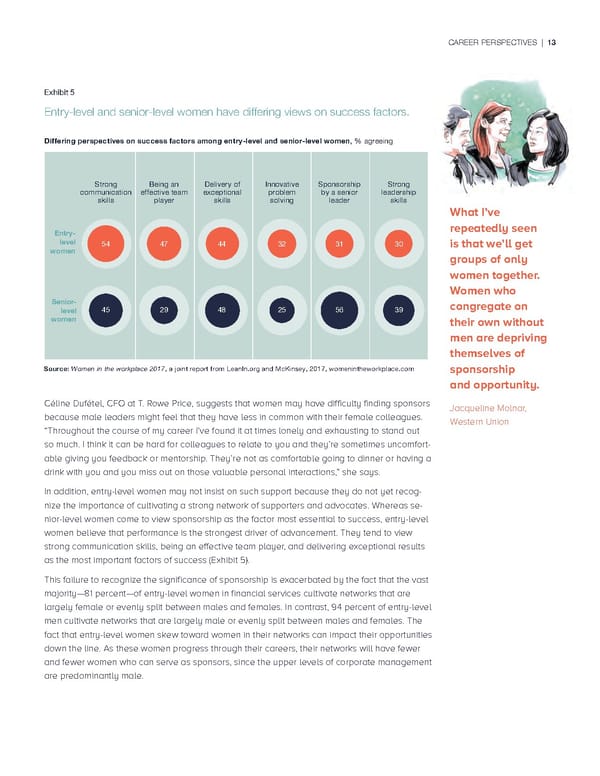CAREER PERSPECTIVES | 13 Exhibit 5 Entry-level and senior-level women have differing views on success factors. Differing perspectives on success factors among entry-level and senior-level women, % agreeing Strong Being an Delivery of Innovative Sponsorship Strong communication effective team exceptional problem by a senior leadership skills player skills solving leader skills What I’ve Entry- repeatedly seen level 54 47 44 32 31 30 is that we’ll get women groups of only women together. Women who Senior- congregate on level 45 29 48 25 56 39 women their own without men are depriving themselves of Source: Women in the workplace 2017, a joint report from LeanIn.org and McKinsey, 2017, womenintheworkplace.com sponsorship and opportunity. Céline Dufétel, CFO at T. Rowe Price, suggests that women may have difficulty finding sponsors Jacqueline Molnar, because male leaders might feel that they have less in common with their female colleagues. Western Union “Throughout the course of my career I’ve found it at times lonely and exhausting to stand out so much. I think it can be hard for colleagues to relate to you and they’re sometimes uncomfort- able giving you feedback or mentorship. They’re not as comfortable going to dinner or having a drink with you and you miss out on those valuable personal interactions,” she says. In addition, entry-level women may not insist on such support because they do not yet recog- nize the importance of cultivating a strong network of supporters and advocates. Whereas se- nior-level women come to view sponsorship as the factor most essential to success, entry-level women believe that performance is the strongest driver of advancement. They tend to view strong communication skills, being an effective team player, and delivering exceptional results as the most important factors of success (Exhibit 5). This failure to recognize the significance of sponsorship is exacerbated by the fact that the vast majority—81 percent—of entry-level women in financial services cultivate networks that are largely female or evenly split between males and females. In contrast, 94 percent of entry-level men cultivate networks that are largely male or evenly split between males and females. The fact that entry-level women skew toward women in their networks can impact their opportunities down the line. As these women progress through their careers, their networks will have fewer and fewer women who can serve as sponsors, since the upper levels of corporate management are predominantly male.
 Closing the Gap Page 14 Page 16
Closing the Gap Page 14 Page 16